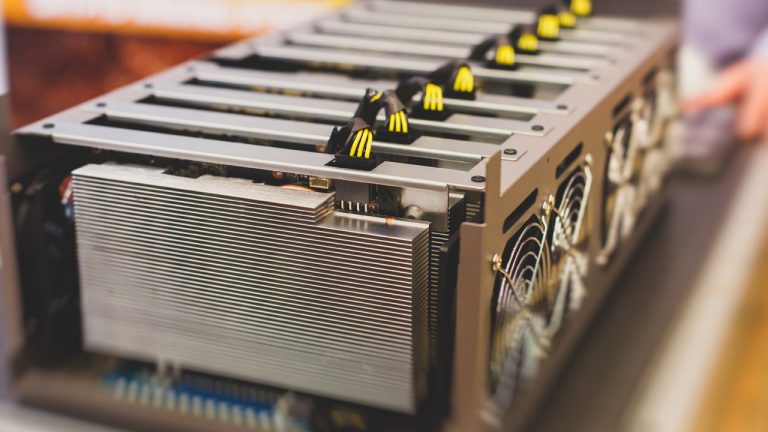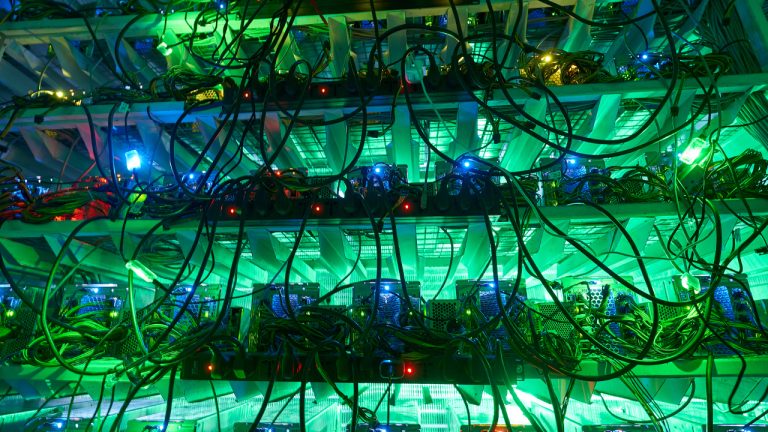
Bitcoin miner TeraWulf mined 699 Bitcoin in Q2 — a 21% year-over-year decline — but still beat analyst expectations with $35.6 million in quarterly revenue.
Bitcoin miner TeraWulf beat revenue and missed earnings expectations as it posted a 21% decline in the amount of Bitcoin it mined in the second quarter of 2024.
In an Aug. 2 second-quarter earnings report, the firm said it mined 699 Bitcoin (BTC) in the second quarter, a 21% decline year over year.
The firm reported second-quarter revenue of $35.6 million, slightly beating the consensus estimate of $35.4 million. However, it posted a quarterly loss of $0.03 per share, falling short of an estimated $0.02 loss per share.

With the tough conditions that faced Bitcoin miners last year, Iris’ co-founder said the purchase was a “significant milestone” for the company.
Australia-based Bitcoin (BTC) mining company, Iris Energy, revealed it will nearly triple its mining capacity with the addition of thousands of mining rigs.
On Feb. 13 the firm said it purchased an additional 4.4 Exa Hashes per second (EH/s) worth of Bitmain Antminer S19j Pro ASIC miners bringing its self-mining capacity to 5.5 EH/s from 2.0 EH/s.
Based on the S19j Pro’s maximum hashrate of 100 Tera Hashes per second (TH/s), the purchase adds an estimated 44,000 miners to its fleet, according to Cointelegraph’s calculations.
Daniel Roberts, Iris’ co-founder and Co-CEO said the purchase “is a significant milestone” for the company and added its been a “challenging period for both the industry and markets more generally.”
Iris said the new miners will be installed in the company’s centers but did not mention in which locations. The firm operates three facilities in various locations in British Columbia, Canada and one in Texas in the United States.

The company used $67 million of remaining prepayments to ASIC miner manufacturer Bitmain to fund the purchase of the rigs “without any additional cash outlay.”
Iris had a 10 EH/s contract with Bitmain which it says “have been fully resolved, with no remaining commitments.” It stated it remains debt free.
The firm said it’s also considering options to sell surplus miners above its 5.5 EH/s of mining capacity to re-invest.
Related: Core Scientific to hand over 27K rigs to pay $38M debt
In November last year the company was forced to unplug miners used as collateral on a $107.8 million loan as the units were producing “insufficient cash flow to service their respective debt financing obligations.”
Over the past few months cryptocurrency miners have faced a squeeze from multiple directions, having to confront low Bitcoin prices amid high hash rates, high mining difficulty and high energy prices.
The pressure caused publicly listed Bitcoin mining companies to sell off almost all of the BTC mined throughout 2022 with data from blockchain research firm Messari showing Iris sold around 100% of the nearly 2,500 BTC it mined that year.
A Febuary analysis from Hashrate Index shows publicly listed miners increased their production in January with better weather and stable electricity prices helping the production surge. Iris’ January production resulted in 172 BTC compared to 123 BTC in December.
 Another bitcoin mining company is dealing with financial issues as Iris Energy’s Form 6-K filing with the U.S. Securities and Exchange Commission (SEC) shows the company could face default on two loans. Iris Energy’s Form 6-K filing explains to the SEC that the firm “received a notice from its lender alleging the occurrence of an […]
Another bitcoin mining company is dealing with financial issues as Iris Energy’s Form 6-K filing with the U.S. Securities and Exchange Commission (SEC) shows the company could face default on two loans. Iris Energy’s Form 6-K filing explains to the SEC that the firm “received a notice from its lender alleging the occurrence of an […] On Nov. 7, 2022, the bitcoin mining firm Core Scientific released the company’s October update after the company’s Form 8-K U.S. Securities and Exchange Commission (SEC) filing on Oct. 26, 2022. The filing noted that the company was in the process of exploring “restructuring its existing capital structure.” The update published on Monday indicates that […]
On Nov. 7, 2022, the bitcoin mining firm Core Scientific released the company’s October update after the company’s Form 8-K U.S. Securities and Exchange Commission (SEC) filing on Oct. 26, 2022. The filing noted that the company was in the process of exploring “restructuring its existing capital structure.” The update published on Monday indicates that […] One of the largest publicly listed bitcoin miners, Core Scientific, has shaken investors with a recent filing with the U.S. Securities and Exchange Commission that raises the possibility the company may apply for bankruptcy protection. The filing notes that Core Scientific will be unable to pay down debt payments due for Oct. and early Nov. […]
One of the largest publicly listed bitcoin miners, Core Scientific, has shaken investors with a recent filing with the U.S. Securities and Exchange Commission that raises the possibility the company may apply for bankruptcy protection. The filing notes that Core Scientific will be unable to pay down debt payments due for Oct. and early Nov. […]
Crusoe Energy Systems has just acquired the operating assets of Great American Mining, a sign that further consolidation could be ahead.
Amid soaring Bitcoin (BTC) mining difficulty and sinking mining profitability, Colorado-based Bitcoin miner Crusoe Energy Systems has announced the acquisition of the operating assets of portable BTC mining operator Great American Mining (GAM).
The deal will see GAM’s operations integrate into Crusoe’s, adding over 10 megawatts (MW) to its mining output and around 4,000 application-specific integrated circuit (ASIC) crypto mining rigs — increasing Crusoe’s capacity by about 9% according to the company.
GAM builds and deploys portable BTC mining facilities — vehicle trailer-mounted containers enclosed with ASIC miners — with the goal of helping oil and gas companies take advantage of stranded or otherwise wasted natural gas by using it to power the facility to mine BTC.
Crusoe will have roughly 125 of these waste gas-powered containers deployed and operating following the acquisition, which it says could reduce an annual CO2-equivalent emission of around 170,000 cars.
The consolidation of these two mining operations comes as the sector faces pressure from both the traditional and crypto markets, along with an all-time high BTC mining difficulty all of which is negatively affecting miner profitability.
Markus Thielen, head of strategy for digital asset services platform Matrixport told Cointelegraph the majority of the mining hashrate moving to the United States over the last two years had “significant consequences” on how the industry was positioned into the wider economic downturn.
“Around 20 Bitcoin mining companies raised additional capital through IPOs where shareholders demanded a high correlation to the underlying Bitcoin price,” he said, explaining orders for new mining machines were placed a year in advance, which was expected to come online in the third quarter of 2022.
“The result was that mining companies bought Bitcoin directly from the market at higher costs than their mining operations and were negatively exposed to further capital expenditure investments as they placed equipment orders a year in advance.”
As miners waited for the equipment some sold significant parts of their BTC reserves to recoup expenditures, but Thielen says “this has not been enough,” and expects an “outright industry restructuring.”
Related: Canaan exec says opportunity outweighs crisis as Bitcoin miners struggle with shrinking profits
Crypto miners such as CleanSpark have already shown to be interested in snapping up cheap assets amid tough market conditions, purchasing over 1,000 ASIC mining rigs at a “substantially discounted price” in July, and 1,800 Antminer S19 XP rigs the month prior.
In September CleanSpark went on to purchase a $33 million facility in the U.S. from Australian-based miner Mawson, spending an extra $9.5 million buying the firms’ 6,468 ASIC mining rigs.
Rising energy costs and the crypto bear market caused mining hosting firm Compute North to file for Chapter 11 bankruptcy in September, with the company owing $500 million to 200 creditors with assets worth anywhere between $100 million and $500 million.
 While the cryptocurrency community prepares for The Merge, the Nasdaq-listed, Hive Blockchain Technologies, revealed in the company’s August 2022 production update that it plans to re-distribute its hashpower dedicated to Ethereum toward “other GPU mineable coins.” Hive’s Technical Team Researches Other GPU Mineable Coins On September 6, Hive Blockchain Technologies (Nasdaq: HIVE) published the company’s […]
While the cryptocurrency community prepares for The Merge, the Nasdaq-listed, Hive Blockchain Technologies, revealed in the company’s August 2022 production update that it plans to re-distribute its hashpower dedicated to Ethereum toward “other GPU mineable coins.” Hive’s Technical Team Researches Other GPU Mineable Coins On September 6, Hive Blockchain Technologies (Nasdaq: HIVE) published the company’s […]